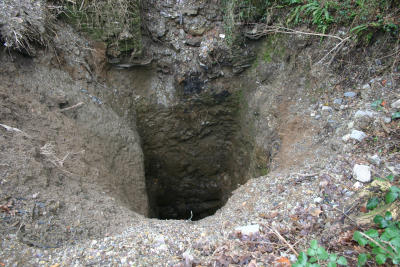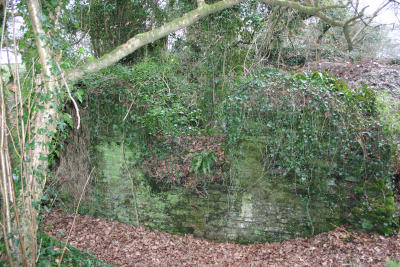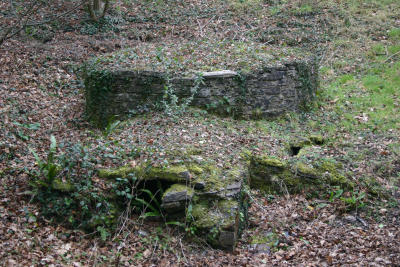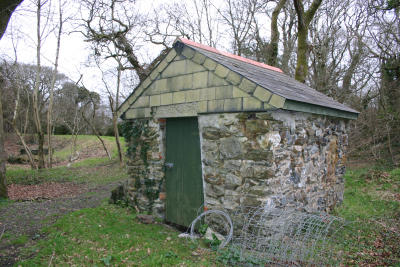 |
| Back filled shaft, but has since dropped 75-100ft |
 |
| Remains of engine house |
TRELAWNEY MINE
 |
| Back filled shaft, but has since dropped 75-100ft |
 |
| Remains of engine house |
 |
|
RRemains of Chimney stack |
 |
|
pPPowder house |
Extracts from the book by, J.H. Murchison, Esq., F.G.S. 1854 report on:-
TRELAWNEY
In 520 Shares. £8 7/8 Paid.
(On the Cost Book System.)
Situate near Liskeard. According to the Mining Journal, the dividends paid have been £23,400, or £45 per share. In 1853, the dividends were £5,200, or £10 per share, and in the first nine months of 1854, they have been £1,040. The mine is believed to be in a prosperous condition, and in a position to continue the dividends.
The following is a copy of the agent's report of 24th October, 1854:-
Smith's shaft is sunk 2½ fathoms below the108 fathom level, ground a little more favourable for sinking. We have just intersected the lode at the 108 fathom level, but are not yet through it; it is producing good lead and flour-spar. In the 98 fathom level, north end, the lode is 2½ feet wide, worth £5 per fathom; in the same level, south end, it is 1 foot wide, worth £7 per fathom. We are still driving by the side of the lode in the 88 fathom level, north end. In the 78 fathom level, north end, the lode is 2 feet wide, worth £5 per fathom. In the 55 fathom level, north end, the lode is 1 foot wide, worth £7 per fathom. Chippendale's shaft is sunk 5 fathoms 4 feet below the 78 fathom level, where the lode is 2 feet wide, worth £8 per fathom. South mine: In the 120 fathom level, south end, no lode taken down since last week. In the 107 fathom level, south end, the lode is 3 feet wide, north £12 per fathom; the lode in the rise in the back of this level, is 3 feet wide, worth £16 per fathom. In the 92 fathom level, south end, the lode is 3 feet wide, producing about 15cwts of copper ore per fathom; in the winze sinking in the bottom of this level, the lode is 2 feet wide, worth £10 per fathom. the stopes and pitches are as much as usual.
October 24th.
J. Kemp.
The present price of the shares is about £39. The office is at Liskeard.
Devonport Journal Thu 8th November 1855
TRELAWNY
At Trelawny a dividend of £1 per share has been declared, and the mine is looking much better. A larger dividend would have been declared, but the expenses were heavy, owing to the extra pit work, and machinery paid for.
Liability Chronicle 2nd March 1857.
TRELAWNEY
At the mines meeting the accounts showed a balance in favour of adventurers of £1122; a dividend of 15s per share was declared.
Mining Journal 3rd January 1857.
TRELAWNY, WHEAL
24th December 1856.
Smith’s Engine Shaft is sunk 2 fathoms 2 feet below the 132, and we have set to sink it to the 142 at £29. 10s per fathom. The lode in the 132, north of the cross-cut, is 6 feet wide, consisting mostly of fluor-spar and lead ore, and worth at least £25 per fathom, set to drive by 6 men, at £4. 10s per fathom; the lode in the south end is quite as large as it is in the north end, but it is more porous, and not so good, worth about £15 per fathom. The lode in the 120 north is 2 feet and worth £8 per fathom; in the same level south the lode has not been taken down, but it will be done forthwith. Chippendale’s Shaft is sunk 4 fathoms 4 feet below the 108, the lode in the 108, north of Chippendale’s is 3 feet wide, and worth £15 per fathom; the south end is communicated the Trehane Mine. The lode in the 98 north is improving, and is now worth £7 per fathom.
South Mine: The lode in the 142, south of Trelawney’s Shaft, is 2 feet wide, and worth £7 per fathom, and judging from the appearances an improvement will soon take place. We have set to drive the north end, the lode in which will be reported upon next week. The lode in the 130 end south is 3 feet wide, and worth £10 per fathom; in the same level north the ground is improving as we anticipated, and hence the lode is improving also; it will more than pay for driving. The lode in the 120 south is 2 ½ feet wide, and worth £10 per fathom; the stopes and pitches are producing a fair quantity of lead ore. We sampled, on Saturday last; 2 parcels of lead ore: 90 tons at £21. 6s per ton; and 40 tons at £6. 10s. The produce of the first parcel was nearly 80 per cent for lead, and 42ozs of silver to the ton.
J. Prince.
Liability Chronicle 1st September 1857.
TRELAWNEY, WHEAL
At the mines meeting the accounts showed a balance in favour of mine of £1,987; the profit on the three months’ working was £1,193; a dividend of £1040 (£1, per share) was declared, and £947 carried to credit of next account.
Report on mines by C. Twite, 31st December 1863.
TRELAWNEY, WHEAL
This is another old established lead mine, working in two principal parts.
There is one large shaft used as an engine and drawing shaft, and two other drawing shafts.
Trelawney’s Shaft. Engine and drawing, perpendicular, and 170 fathoms deep. 2 kibbles used, with chains.
The other drawing shafts are respectively 160 and 180 fathoms deep, underlaying 1 foot per fathom. These have one kibble in each, worked by the same engine.
There are two ladder ways for the men. The ladders are in 4 to 5 fathom lengths, underlaying 20 inches per fathom.

The drying and changing houses form the end and side of a rectangular yard. In the centre is a shed with lockers built in a wall for holding the powder, and containing the men's chests.
No. 1 is 60 feet long, 16 wide, and 11 feet high. It has one fixed glass window, one one, and a ventilator in the roof. It is warmed by means of a fire and tube. An aperture is formed round the fire for wanning dinners. There arc raised planks for the men to stand upon while changing. About KM) men and boys change here.
In winter the females eat their dinners here.
No. '2 is 30 feet long, 12 wide, and 12 high. No roof ventilator. It is warmed by a tube passing from the fire to the sump house.
The sump house is for the shaftmen; good fire.
Pitmen and timbermen's house very comfortable. It has a wooden floor and good fire.
The dressing mostly carried on under roofed sheds.
In the north part of the mine the dressing also under sheds, but no provision for girls to warm their dinners, etc, other than the engine house.
TRELAWNEY, WHEAL
In the parish of Menheniot, commenced in February, 1843. There has been a profit on the working. The lords are, Charles Trelawny, Esq., and John Carthew’s representatives. Dues 1-15th. One lode only worked. Depth, 182 fathoms. Two engines, of 70 and 50-inch respectively, pump the water, and two engines, each 22-inch, draw the stuff. A water-wheel crushes the ore. Agents, Captain R. Pryor and T. Grenfell; manager, Captain Francis Pryor; purser, Mr. Thomas Pryor, Redruth; secretaries, Messrs. Dunsford and Ranken, London.
The Railway Register 1846, page 42
TRELAWNEY, WHEAL
The richest lead mine in the Liskeard area, is wheal Trelawney, in the parish of Menheniot, about three miles from Liskeard. It has been at work about two years; the outlay by the shareholders has not been more than £2,000, whilst the dividends paid have amounted to £2,080, and the mine is now paying at the rate of £6,240 per annum. The returns are 50 tons of silver lead ore, worth £18 per ton per month, at a cost of about £350 per month. Ere long it is expected the returns will be greatly increased. The steam engine is a 22-inch cylinder, and it is hoped, able to carry them down to the 42-fathom level The shaft is now down 32 fathoms, and the deepest level is the richest. There can be no difference of opinion that the mine is the prettiest in the district.
The Railway Register 1846, page 43
TRELAWNEY, SOUTH WHEAL
This is an extensive sett, adjoining Mary Ann, and is supposed also to take the Trelawney lode. At the north boundary, near Menheniot Church Town, a shaft has been sunk 8 fathoms, and a level driven on Soby's lode for 40 fathoms, which, has averaged about 3 feet wide, and promising. At the south part of the sett, when we were there, they were sinking pits, and found the lode containing small particles of lead. It is their intention, we believe, to sink a shaft here immediately. The works should be prosecuted vigorously, and the shareholders may one day have a good mine.